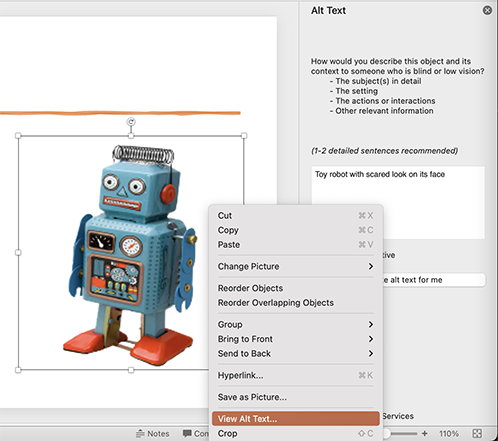
TABLE OF CONTENTS
- Tip 1: Add a document title
- Tip 2: Ensure each slide has a Slide Title
- Tip 3: Add alt text to images
- Tip 4: Lists should use list items
- Tip 5: Use helpful link text
- Tip 6: Ensure the text has good color contrast
- Tip 7: Manage Content Reading Order
- Tip 8: Accessibility Checker
- How to export a PowerPoint document to PDF for accessibility
TIP 1: ADD A DOCUMENT TITLE UNDER “FILE PROPERTIES”:
The file properties for every document should include a brief and accurate title. The document title is the first thing a screen reader will read aloud.
ADD A "TITLE" ON MAC:
- Go to the top menu and choose "File > Properties..."
- In that dialog box go to the "Summary" tab.
- Fill in the "Title" field.
ADD A "TITLE" ON WINDOWS:
- Go to the top Ribbon menu and choose "File". It will slide out a new page.
- Look on the right under the Properties heading for the word "Title".
- Click the area to the right of the "Title" which says "Add a title".
- Fill in the "Title" field.
Tip 2: Ensure every slide has a Slide title:
- Each slide needs a Slide Title area so that screen reader users will know what the slide will be about.
- Slide Titles should be unique and descriptive to help users navigate the Slide deck. To differentiate slides with identical titles, consider adding a number after each Slide Title. For example, "About PPT Slide Titles, 1", followed by "About PPT Slide Titles, 2".
- Never remove the Slide Title element. If you do not the Slide Title to be visible, you can move it off the edge of the slide. This will preserve the Slide Title information for screen reader users but it will not be visible in the Presentation View.
Tip 3: Add alt text to images:
Alt text is a short description of an image. It ensures that images are accessible to screen reader users.
1. Right-click on an image. Select "View Alt Text...". (This may be “Edit Alt Text” in other versions of PowerPoint.) This will open an "Alt text" panel on the right.

2. Describe what is important about this image in the context of the text that surrounds it.
TIP 4: LISTS SHOULD USE LIST ITEMS:
Create lists using PowerPoint’s “list item” buttons (as opposed to typing in dashes or asterisks). List items help screen readers recognize the information as a list rather than a string of sentences. For example, if a list is created with list items, screen readers can announce the total number of items in the list and indicate what number on the list is currently being read to the user.
Example of list items buttons in PowerPoint.

Tip 5: Use helpful link text:
It is important that links describe what they do and where they will take the user.
Bad link text:
- Using "Read more" or "Learn more" are a bad habit because it does not indicate where it will take the user.
- Using full URLs like "https://biglongurl.org/foobar/43245" is bad because it does not mean anything to screen readers. It's just a bunch of letters and numbers. It does not indicate what the link is for.
Learn more on our hyperlink explanation page.
Doing this on Mac and Windows looks a little different.
On Mac
1. Highlight the entire URL, then right-click and choose "Hyperlink".
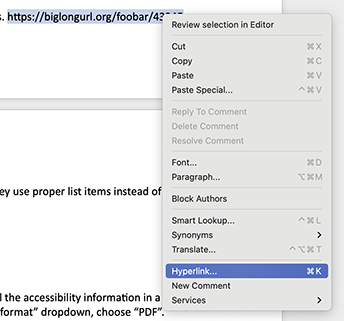
2. Change the "Text to Display" to a short description of the link's destination. This is the text that will be hyperlinked.
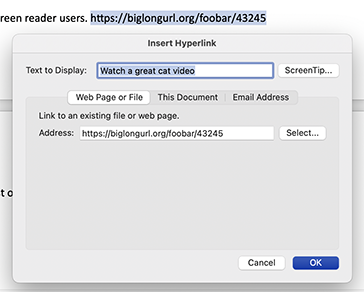
On Windows:
1. Highlight the entire URL, then right-click and choose "Link".

2. Change the "Text to Display" to a short description of the link's destination. This is the text that will be hyperlinked.
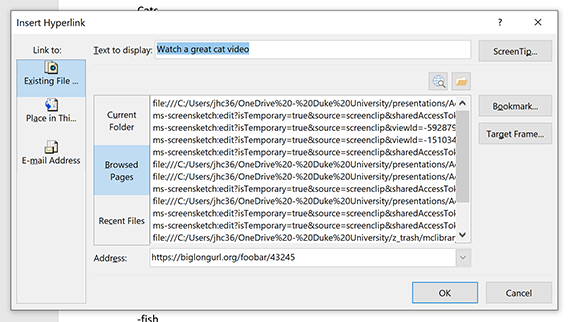
Tip 6: Ensure the text has good color contrast:
It is important for people to be able to easily read the text on your page. Avoid colors like yellow or light grey. Read more about it on our color contrast page.
Some PowerPoint Themes have more accessible colors than others. Choose Themes that appear to have good color contrast on the text, headings, and links.

Poor color contrast will likely be discovered when you run the Accessibility Checker.
Tip 7: Manage Content Reading Order:
Screen reader users depend on a logical reading order to understand the order of content on a slide. To check and modify the reading order we use the "Selection Pane".
NOTE: The selection pane will show the content elements in reverse order. For example, elements at the bottom of the list in the selection pane will be read first by a screen reader.
Tip 8: Accessibility Checker:
There is a built-in Accessibility Checker on most Microsoft Office products. Note that not all of the issues it flags are barriers to access; if you follow the previous seven tips listed here, your document should be in good shape. When you select an issue in the accessibility checker, it provides tips on why it might be a problem and steps to fix the issue.
To open it:
1. In the top Ribbon, click the "Review" tab.
2. Select the "Accessibility Checker" button.

3. This will open a panel to the right of the document. Review the issues.
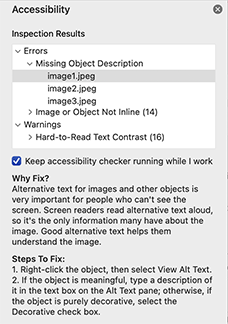
NOTE 1: You can leave it as a PowerPoint document (preferred), or save it as a PDF.
NOTE 2: If you are saving it as a PDF, follow the instructions below. You must export it correctly to preserve the document’s accessibility features.
How to export a PowerPoint document to PDF for accessibility
This is different between a Mac and PC.
Save a PDF on a Mac:
Option 1:
Choose "File > Save as...".

Expand the "File format" dropdown and select "PDF".

Option 2:
If you have Adobe Acrobat Installed, you will likely have an Acrobat tab with a "Create PDF" button. If you have that, you can choose that option.

Option 2: The other option is to use Robobraille, which will also produce a quality accessible PowerPoint PDF.
SAVE PDF ON WINDOWS:
Choose "File > Save As...", then "Browse".

From the"Save as type" dropdown menu, choose "PDF".
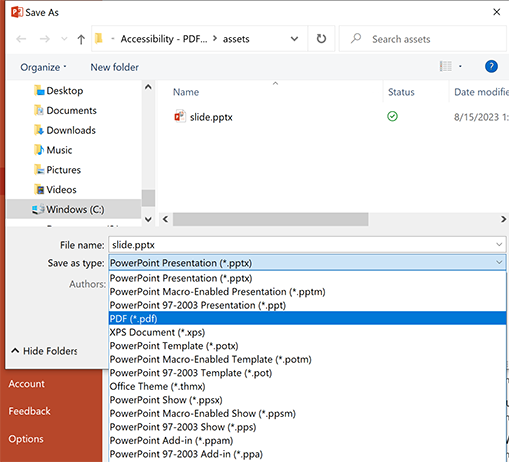
Note: If you have a "Save as Adobe PDF" button, you can use that instead. They produce slightly different results. One is not necessarily better than the other.
For more comprehensive training watch LinkedIn Learning Creating Accessible PDFs. It is free when you log in using your Duke email address.